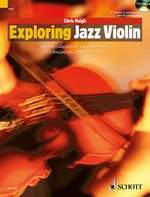
MENU TO FIDDLE STYLES:
JEAN-LUC PONTY
Jean Luc Ponty was born in Avranches, France in 1942, into a family of musicians. His father taught him violin from the age of 5, and at the age of 13 quit school in order to practice intensively. At 16 he entered the Paris Conservetoire, where he graduated two years later as the prize student. He was immediately hired by a symphony orchestra, with which he played for three years.
Whilst still in Paris with the orchestra, he started playing clarinet with a local college jazz band. He started this purely for fun, but was quickly seduced by both the freedom and intellectual challenge of improvisation. He knocked on Stephane Grappelli's door and introduced himself; Grappelli subsequently came to see him play, and was very encouraging. However, Ponty had no intention of following the footsteps of the older player; he avoided the sentimentality and nostalgia of 40's Parisian swing, turning instead towards the more cool, modern and challenging sounds of American bebop, particulaly Miles Davis and John Coltrane.
Jean Luc Ponty; bebop violin technique
He was among the first violinists to make this break. In terms of playing technique it meant avoiding the linear, melodic sweetness that is so natural to the violin, seeking instead angularity and punchy, horn-like phrasing. He cut vibrato out of his playing almost completely, even on ballads, giving his playing a compelling stark quality. His approach to chords was very modern, with many altered notes such as flattened and sharpened ninths, chords extended to 11th and 13ths, and many chromatic passages. He made extensive use of octaves, often combined with agressive, choppy rhythms, and would sometimes play unison notes on two strings, (fingering a note on one string with his first finger, and on the next string down with his fourth, requiring an added stretch,)
An ornament which became something of a trademark, is the dragging or sliding down of a note at the end of a phrase.
His abandoned his classical career to pursue jazz full-time, though he was very grateful for hisclassical technique which, though a hindrance at first, gave him superb control of bowing and intonation.He released two landmark bebop albums; Jazz Long Playing in 1964 and Sunday Walk in '67; he favoured a piano/bass/drums accompaniment rather than the guitar- led combos typical of Grappelli or Venuti, and the material was mostly bebop standards, though he was already beginning to introduce his own compositions. An important milestone in his career was his appearance at the legendary Violin Summit in Basel, alongside Grappelli, Svend Asmussen and Stuff Smith.
Ponty with Frank Zappa
In 1969 he began working with Frank Zappa, appearing first on one track of the Hot Rats album; Zappa then wrote and produced a solo album for Ponty, entitled King Kong. When invited to tour live with Zappa's Mothers of Invention, Ponty left Paris and moved to LA. Other collaborations at the same period included an appearance on an Elton John album, and more significantly a pairing with John McLoughlin's Mahavishnu Orchestra.
Jazz-rock fusion violin
His playing by this time was taking a different direction. He was already beginning to find bebop old-fashioned and restrictive, and was moving into jazz-rock fusion. When he moved to the States he began using electric violins, ideal for playing with loud bands, and with more possibilities for manipulating the sound. He championed the Barcus Berry violins, and was particularly taken with the baritone version of the violin which could play an octave lower, and was good for playing unison melodies with sax or electric guitar. Ponty began to forge a unique sound using effects pedals, particularly chorus and phasing.
Through the 70's he released a series of solo albums with psychadelic titles such as Imaginary Voyage, Enigmatic Ocean and Cosmic Messanger. The material on these albums was largely self-written-sprawling compositions based on minimalist, repeated melodic units. The extended solos were often modal in nature, the overall feel tense, dark and introspective. Unlike his predecessors such as Stuff Smith or Joe Venuti, Ponty has never been one to include much lightness or humour in his playing.
As technology developed, he continued to stay at the forefront, switching to the solid- bodied Zeta violin, with an individual pickup for each string. When the Zeta finally became midi-compatible, he was finally able to shape the sound in any way he wanted..
Since the 80's, Ponty has begun to change direction again, experimenting with West African rhythms (his Tchokola project), with Indian jazz fusion (paired with L.Subramaniam), and finally with a return to acoustic music, working with Al Dimeola, Stanley Clarke and Bela Fleck.
RETURN TO CHRIS HAIGH'S JAZZ VIOLIN PAGE
RETURN TO JAZZ VIOLIN LESSONS PAGE
RETURN TO FIDDLING AROUND THE WORLD HOMEPAGE
Recorded in 1964, Jazz Long Playing is the hidden treasure at the bottom of Ponty’s vault. It is not widely known that, sandwiched between his brief classical career and his much longer reign as the jazz fusion violin king, Ponty was a bebop player extraordinaire. Only Didier Lockwood has come anywhere near him since. This album, recorded with piano, bass, drums and a little flute has all the evidence you need. Recorded with no effects, and with an almost total absence of vibrato, Ponty achieved a sound equivalent to, and no doubt modelled on, that of Miles Davis circa Kind of Blue. His playing is peppered with unexpected double stops, dissonances and altered notes. On the two blues numbers- YTNOP Blues and Sniffin the Blues the outside notes and chord substitutions are easiest to follow. On the medium tempo numbers such as Une Nuit au Violon and Spanish Castels, his solos move effortlessly from swing 8ths to straight 16th notes, while the up tempo tunes such as Postlude in C or Au Privave, the notes pour out like water from a tap. Perhaps most interesting are the ballads. How would he deal with a romantic gypsy jazz standard such as Django Reinhardt’s Manoir de mes Reves? With no vibrato or gypsy inflection to his playing you would expect it to fall flat, but not a bit of it. Playing a straight bat, and with total confidence, Ponty turns this into a bebop masterpiece. If all you’ve ever heard of jazz violin is swing or jazz fusion, this album is a must.




